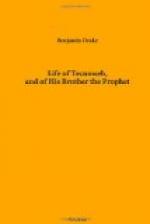Logan, Elenipsico, Red Eagle, and Packishenoah, the
last of whom was killed. Cornstalk, the chief
in command, was conspicuous for his bravery, and animated
his followers in tones which rose above the clash
of arms; and when a retreat became necessary, conducted
it so successfully and with so much delay, as to give
his men an opportunity of bearing off all their wounded
and many of the killed, whose bodies were thrown into
the river. The loss of the Indians was never
ascertained. One of the historians already quoted,
speaks of it as “comparatively trifling.”
The character of our troops, many of whom were experienced
woods-men, familiar with Indian fighting, the long
continuance of the action—from the rising
to the going down of the sun—the equality
in numbers and position of the contending parties,
the known usage of the Indians in hiding their dead
and carrying off the wounded, the number of killed
found on the battle ground the following day, and
the severe loss of the Virginians, all forbid the
idea that the loss of the enemy could have been trifling.
The Ohio and Kanawha rivers afforded them opportunities
for concealing their dead, while the plan of retreat,—alternately
giving ground and renewing the attack,—was
no doubt adopted for the purpose of gaining time to
remove the wounded across the Ohio. It is fair
to assume that the loss of the Indians was not far
short of that sustained by the whites.
All circumstances considered, this battle may be ranked
among the most memorable, and well contested, that
has been fought on this continent. The leaders,
on either side, were experienced and able, the soldiers
skilful and brave. The victorious party, if either
could be so called, had as little to boast of as the
vanquished. It was alike creditable to the Anglo-Saxon
and the aboriginal arms.
After the Indians had recrossed the Ohio, they marched
to the valley of the Scioto, and encamped on the east
side of that stream, about eight miles north of where
Chillicothe now stands. Here a council was held
to decide upon their future movements. Cornstalk,
although true to the interests of the Shawanoes, was
the friend of peace, and had been opposed to making
the attack on the troops of general Lewis. Being
overruled, he entered into the action determined to
do his duty. He now rose in the council and demanded,
“What shall we do now? The Long Knives
are coming upon us by two routes. Shall we turn
out and fight them?” No reply being made
to his questions, he continued, “shall we kill
all our women and children, and then fight until we
are all killed ourselves?” The chiefs were still
silent. Cornstalk turned round, and striking
his tomahawk into the war-post standing in the midst
of the council, said with his characteristic energy
of manner, “Since you are not inclined to
fight, I will go and make peace.”




